An Evaluation of the Microstructure and Hardness of Co-Rich PTA Overlays on a Duplex Steel Substrate
Abstract
1. Introduction
2. Materials and Methods
3. Results
3.1. Powder Charakterization
3.2. Surface Morphology
3.3. Microstructure Evaluation of Substrete Material
3.4. Microstructure Evaluation of Transition Zone
3.5. Microstructure Evaluation of Overlay Weld
3.6. Hardness Measurements
4. Discussion
5. Conclusions
- The examination of the sprayed layers indicates a favorable and uniform distribution of dispersive precipitates of the strengthening phase in the cross-section. The strengthening phase is formed by tungsten carbides and eutectics, and it should be assumed that the share of the eutectic structure is crucial for abrasion resistance.
- The overlay weld is characterized by a lack of porosity and may contain single transverse and longitudinal cracks resulting from the structure and the occurrence of eutectics in the interdendritic areas. The key parameter is to ensure the appropriate cooling conditions, which should be determined experimentally.
- At the substrate–coating boundary, there is a narrow (up to approximately 0.1 mm) transition layer free of precipitates, formed mainly by mixing the powder matrix and the substrate metal. The substrate surface has melted to a small extent, ensuring good adhesion of the coating in areas where the surface was wetted and a small share of iron in the coating. Therefore, it should be assumed that it is possible to produce single-layer coatings, which ensures their small thickness with limited iron content on the surface.
- In the case of improper surface conditions, a brittle area of the overheated substrate with σ phase precipitates may form in the HAZ. The presence of the σ phase was observed in all 5 samples tested. The tested coatings did not reveal the presence of a continuous band of σ phase precipitates, ensuring a low risk of the coating detaching from the substrate.
- The surfacing conditions ensured favorable hardness (approximately 600 HV10) of the coating, which ensures high abrasion (wear) resistance. However, the high hardness should be attributed exclusively to carbide precipitates. Favorable results were obtained without additional post-surfacing processing (aging), which could promote carbide growth.
- It should be assumed that the smooth transition will help to avoid crack development in that region.
Funding
Institutional Review Board Statement
Informed Consent Statement
Data Availability Statement
Conflicts of Interest
References
- Zhang, H.; Mei, K.; Guo, W.; Li, Z.; Lai, Y.; Zhao, W.; Xiao, G.; Zhang, Y.; Cha, X. Comparative study on microstructures and properties of air-cooled and water-cooled Fe-based plasma arc cladding layers. J. Mater. Res. Technol. 2023, 23, 1599–1608. [Google Scholar] [CrossRef]
- Wang, L.; Chai, L.; Xu, S.; Liu, S.; Gan, S.; Chen, L.; He, X.; Polcar, T.; Daghbouj, N.; Li, B. Study on the corrosion behavior of laser surface remelted and laser cladding of ferritic/martensitic steels after exposure to lead-bismuth eutectic at 700 °C. J. Nucl. Mater. 2024, 590, 154888. [Google Scholar] [CrossRef]
- Xu, N.; Pang, C.; Tong, W.; Liu, J.; Li, L.; Xu, P. Evaluation of microstructure, mechanical properties and osseointegration capacity of laser cladding β-type TiNbZr coatings. Mater. Today Commun. 2024, 41, 110298. [Google Scholar] [CrossRef]
- Sigmund, M. Plasma overlay welding of cobalt alloy. MM Sci. J. 2019, 2019, 2982–2986. [Google Scholar] [CrossRef]
- Zhao, J.; Gao, Q.; Wang, H.; Shu, F.; Zhao, H.; He, W.; Yu, Z. Microstructure and mechanical properties of Co-based alloy coatings fabricated by laser cladding and plasma arc spray welding. J. Alloys Compd. 2019, 785, 846–854. [Google Scholar] [CrossRef]
- Chen, C.; Li, W.; Tu, F.; Qin, T. Effect of Heat Input on Tin Bronze-Induced Intergranular Cracks During Arc Cladding Process. Crystals 2024, 14, 926. [Google Scholar] [CrossRef]
- Momin, A.G.; Khatri, B.C.; Chaudhari, M.; VShah, U.; Valaki, J. Parameters for cladding using plasma transfer arc welding—A critical. Mater. Today Proc. 2023, 77, 614–618. [Google Scholar] [CrossRef]
- Sankarapandian, S.; Kumar, N.P.; Kannan, A.R.; Shanmugam, N.S. Microstructure, Mechanical Properties, and Corrosion Behavior of Co-Based Stellite 6 Multilayer Overlays Deposited on ASTM A36 Steel by Gas Metal Arc Welding Process. Steel Res. Int. 2023, 94, 2200889. [Google Scholar] [CrossRef]
- Xiong, J.; Nie, F.; Zhao, H.; Zheng, L.; Luo, J.; Yang, L.; Wen, Z. Microstructure evolution and failure behavior of stellite 6 coating on steel after long-time service. Coatings 2019, 9, 532. [Google Scholar] [CrossRef]
- Giudice, F.; Missori, S.; Scolaro, C.; Sili, A. A Review on Metallurgical Issues in the Production and Welding Processes of Clad Steels. Materials 2024, 17, 4420. [Google Scholar] [CrossRef] [PubMed]
- Kabakcı, F.; Acarer, M. Effect of cobalt on Microstructure and toughness properties of 9Cr-1.8W-0.4Ni-xCo weld metal. Int. J. Press. Vessel. Pip. 2024, 211, 105285. [Google Scholar] [CrossRef]
- Hu, K.; Tian, Y.; Jiang, X.; Yu, H.; Sun, D. Microstructure regulation and performance of titanium alloy coating with Ni interlayer on the surface of mild steel by laser cladding. Surf. Coat. Technol. 2024, 487, 130939. [Google Scholar] [CrossRef]
- Kannan, T.; Murugan, N. Effect of flux cored arc welding process parameters on duplex stainless steel clad quality. J. Mater. Process. Technol. 2006, 176, 230–239. [Google Scholar] [CrossRef]
- Rozmus-Górnikowska, M.; Cieniek Blicharski, M.; Kusiński, J. Microstructure and microsegregation of an inconel 625 weld overlay produced on steel pipes by the cold metal transfer technique. Arch. Metall. Mater. 2014, 59, 1081–1084. [Google Scholar] [CrossRef]
- Zhao, X.; Wang, Z.; Jin, J.; Huang, Y.; Yue, C.; Yang, L. Study on the in-situ generation of hard phases and microstructural and mechanical properties in Ni-WC/W2C cladding layers prepared by TIG arc. Int. J. Refract. Met. Hard Mater. 2025, 128, 106985. [Google Scholar] [CrossRef]
- Rykała, J.; Różański, M. Plasma Transferred Arc (PTA) Cladding and TOPTIG Cladding of Tubes Made of Steel 13CrMo4-5. Biul. Inst. Spaw. 2021, 6, 37–45. [Google Scholar] [CrossRef] [PubMed]
- Liu, F.; Liu, C.; Chen, S.; Tao, X.; Zhang, Y. Laser cladding Ni-Co duplex coating on copper substrate. Opt. Lasers Eng. 2010, 48, 792–799. [Google Scholar] [CrossRef]
- Ma, W.; Xu, X.; Xie, Y.; Bei, Z.; Yuan, Y.; Yu, H.; Sun, D. Microstructural evolution and anti-corrosion properties of laser cladded Ti based coating on Q235 steel. Surf. Coat. Technol. 2024, 477, 130383. [Google Scholar] [CrossRef]
- Li, D.; Zhang, C.; Wang, R.; Zhang, J.; Hu, R.; Zhang, Y.; Li, G.; Lu, X. Microstructure and properties evolution of Co06/Ni60A duplex coating on copper by plasma cladding. Surf. Coat. Technol. 2022, 429, 127978. [Google Scholar] [CrossRef]
- Huang, J.; Liu, S.; Yu, S.; An, L.; Yu, X.; Fan, D.; Yang, F. Cladding Inconel 625 on cast iron via bypass coupling micro-plasma arc welding. J. Manuf. Process. 2020, 56, 106–115. [Google Scholar] [CrossRef]
- Deng, X.; Zhang, G.; Wang, T.; Ren, S.; Bai, Z.; Cao, Q. Investigations on microstructure and wear resistance of Fe-Mo alloy coating fabricated by plasma transferred arc cladding. Surf. Coat. Technol. 2018, 350, 480–487. [Google Scholar] [CrossRef]
- Bozeman, S.C.; Isgor, O.B.; Tucker, J.D. Effects of processing conditions on the solidification and heat-affected zone of 309L stainless steel claddings on carbon steel using wire-directed energy deposition. Surf. Coat. Technol. 2022, 444, 128698. [Google Scholar] [CrossRef]
- da Cruz Junior, E.J.; Varasquim, F.M.F.A.; de Mendonça, V.R.; Ventrella, V.A.; Gonçalves, A.C.; Fagundes Junior, J.G.; Zambon, A.; Calliari, I. Impact of Heat Input on the Cladding of Super Austenitic Stainless Steel Through the Gas Tungsten Arc Welding Process on ASTM A516 Grade 70 Steel. Coatings 2024, 14, 1356. [Google Scholar] [CrossRef]
- Kim, H.; Jang, H.; Obulan Subramanian, G.; Kim, C.; Jang, C. Development of alumina-forming duplex stainless steels as accident-tolerant fuel cladding materials for light water reactors. J. Nucl. Mater. 2018, 507, 1–14. [Google Scholar] [CrossRef]
- Chen, K.J.; Lin, H.M. Effects of Niobium Carbide Additions on Ni-Based Superalloys: A Study on Microstructures and Cutting-Wear Characteristics through Plasma-Transferred-Arc-Assisted Deposition. Coatings 2024, 14, 167. [Google Scholar] [CrossRef]
- Farias, F.W.C.; Filho, J.d.C.P.; Júnior, D.A.d.S.; de Moura, R.N.; Rios, M.C.G. Microstructural characterization of Ni-based superalloy 625 clad welded on a 9% Ni steel pipe by plasma powder transferred arc. Surf. Coat. Technol. 2019, 374, 1024–1037. [Google Scholar] [CrossRef]
- Eswara Prasath, N.; Selvabharathi, R. Influence of Plasma Transfer Arc Cladding of NiCrBFe filler powder on microstructure and tensile properties of Titanium Grade 2 and Ti 6Al-4V alloy dissimilar joint prepared by laser beam welding. Opt. Laser Technol. 2020, 128, 106206. [Google Scholar] [CrossRef]
- Kishore, K.; Jaiswal, N.; Prabhakaran, A.; Arora, K.S. Through-thickness microstructure and wear resistance of plasma transferred arc Stellite 6 cladding: Effect of substrate. CIRP J. Manuf. Sci. Technol. 2023, 42, 24–35. [Google Scholar] [CrossRef]
- Bin, K.; Yao, P.; He, R.; Zhang, P.; Zhu, Q. Effect of ZrC particle on microstructure and corrosion behavior of CoCrNi medium-entropy alloy fabricated by powder plasma arc cladding. J. Alloys Compd. 2024, 1008, 176612. [Google Scholar] [CrossRef]
- Duan, B.; Han, F.; Lin, N.; Nouri, M.; Liu, Z.; Yu, Y.; Zeng, Q.; Li, D.; Wu, Y. Wear performance of CoCrFeMnNi and CoCrFeMnNi-SiC coatings on 0Cr18Ni9Ti stainless steel fabricated by plasma transfer arc cladding. Tribol. Int. 2024, 200, 110163. [Google Scholar] [CrossRef]
- Li, C.; Kong, F.; Feng, L.; Sun, H.; Han, X.; Luo, F. Research on Ni-WC Coating and a Carbide Solidification Simulation Mechanism of PTAW on the Descaling Roll Surface. Coatings 2024, 14, 1490. [Google Scholar] [CrossRef]
- Mei, K.; Zhang, H.; Gao, H.; Guo, N.; Zhao, W. Microstructure and properties of Fe-VC pulsed plasma arc cladding layers under different cooling conditions. Ceram. Int. 2023, 50, 6490–6498. [Google Scholar] [CrossRef]
- Adamiak, M.; Appiah AN, S.; Żelazny, R.; Batalha, G.F.; Czupryński, A. Experimental Comparison of Laser Cladding and Powder Plasma Transferred Arc Welding Methods for Depositing Wear-Resistant NiSiB + 60% WC Composite on a Structural-Steel Substrate. Materials 2023, 16, 3912. [Google Scholar] [CrossRef]
- Yoon, B.H.; Ahn, Y.S.; Lee, C.H. The Effect of Dilution on HAZ Liquation Cracking in PTAWNi-Base Superalloys Overlay Deposit. ISIJ Int. 2002, 42, 178–183. [Google Scholar] [CrossRef]
- DuPont, J. Solidification of an Alloy 625Weld Overlay. Metall. Mater. Trans. A 1996, 27, 3612–3620. [Google Scholar] [CrossRef]
- Örnek, C.; Mansoor, M.; Larsson, A.; Zhang, F.; Harlow, G.S.; Kroll, R.; Carlà, F.; Hussain, H.; Derin, B.; Kivisäkk, U.; et al. The Causation of Hydrogen Embrittlement of Duplex Stainless Steel: Phase Instability of the Austenite Phase and Ductile-to-Brittle Transition of the Ferrite Phase–Synergy between Experiments and Modelling. Corros. Sci. 2023, 217, 111140. [Google Scholar] [CrossRef]
- Dong, L.; Peng, Q.; Xue, H.; Han, E.-H.; Ke, W.; Wang, L. Correlation of Microstructure and Stress Corrosion Cracking Initiation Behaviour of the Fusion Boundary Region in a SA508 Cl. 3-Alloy 52M DissimilarWeld Joint in Primary PressurizedWater Reactor Environment. Corros. Sci. 2018, 132, 9–20. [Google Scholar] [CrossRef]
- Kiszka, A.; Górka, J.; Kiszka, P. Plasma Powder Surfacing of Toughened Steel S690Q Performed Using the NiBSi Powder with a Tungsten Carbide Addition. Biul. Inst. Spaw. 2018, 2018, 43–50. [Google Scholar] [CrossRef][Green Version]
- Tuz, L. Determination of the causes of low service life of the air fan impeller made of high-strength steel. Eng. Fail. Anal. 2021, 127, 105502. [Google Scholar] [CrossRef]
- Pu, J.; Xie, P.; Long, W.; Wu, M.; Sheng, Y.; Sheng, J. Effect of Current on Corrosion Resistance of Duplex Stainless Steel Layer Obtained by Plasma Arc Cladding. Crystals 2022, 12, 341. [Google Scholar] [CrossRef]
- ISO 3452-1:2021; Non-Destructive Testing—Penetrant Testing. Part 1: General Principles. ISO: Geneva, Switzerland, 2021.
- Yoo, C.-S.; Söderlind, P.; Cynn, H. The phase diagram of cobalt at high pressure and temperature: The stability of -cobalt and new -cobalt. J. Phys. Condens. Matter 1998, 10, L311–L318. [Google Scholar] [CrossRef]
- Hou, Q.Y.; Gao, J.S.; Zhou, F. Microstructure and wear characteristics of cobalt-based alloy deposited by plasma transferred arc weld surfacing. Surf. Coat. Technol. 2005, 194, 238–243. [Google Scholar] [CrossRef]
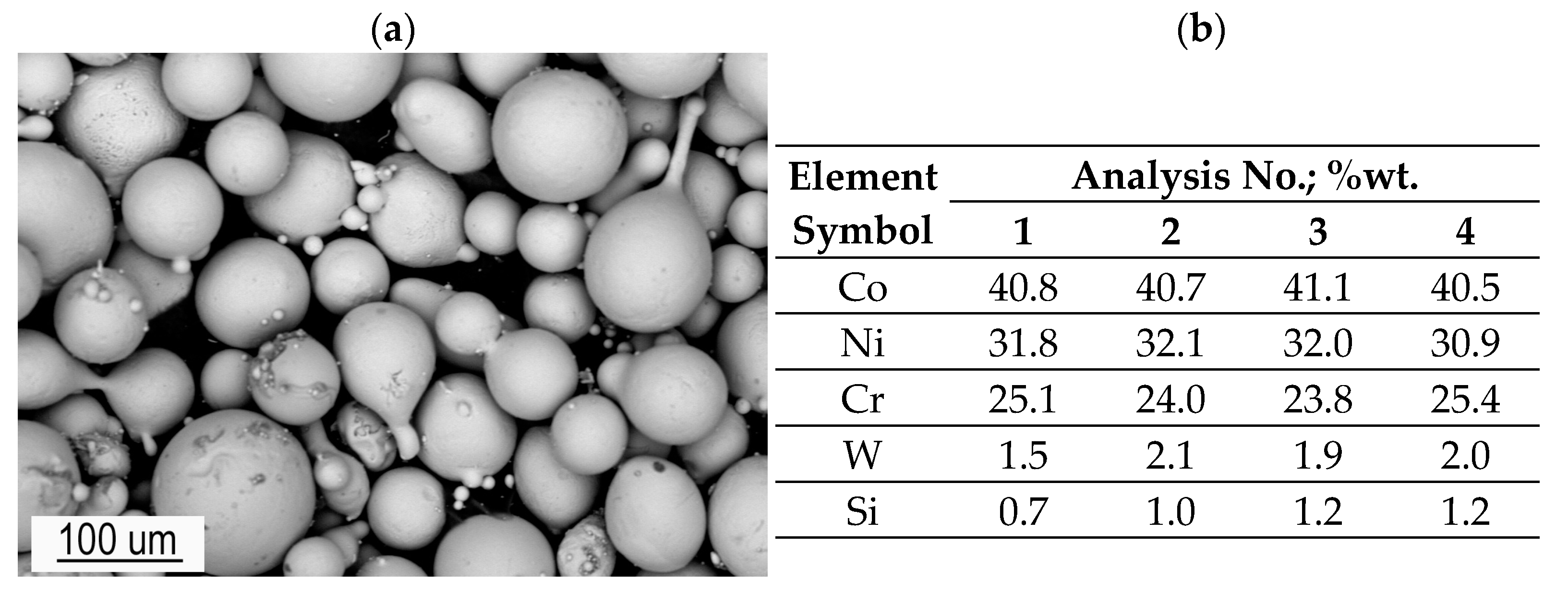

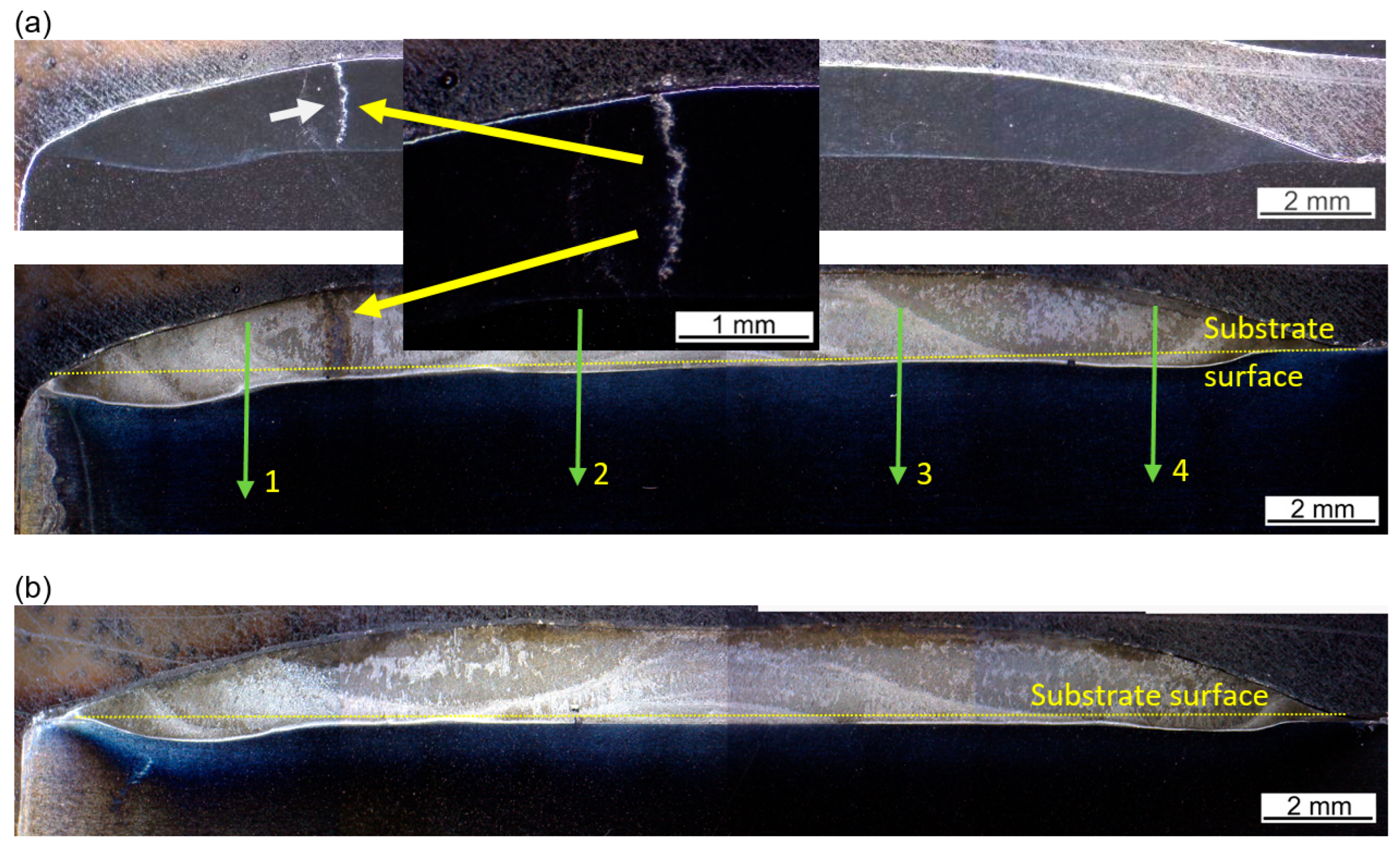

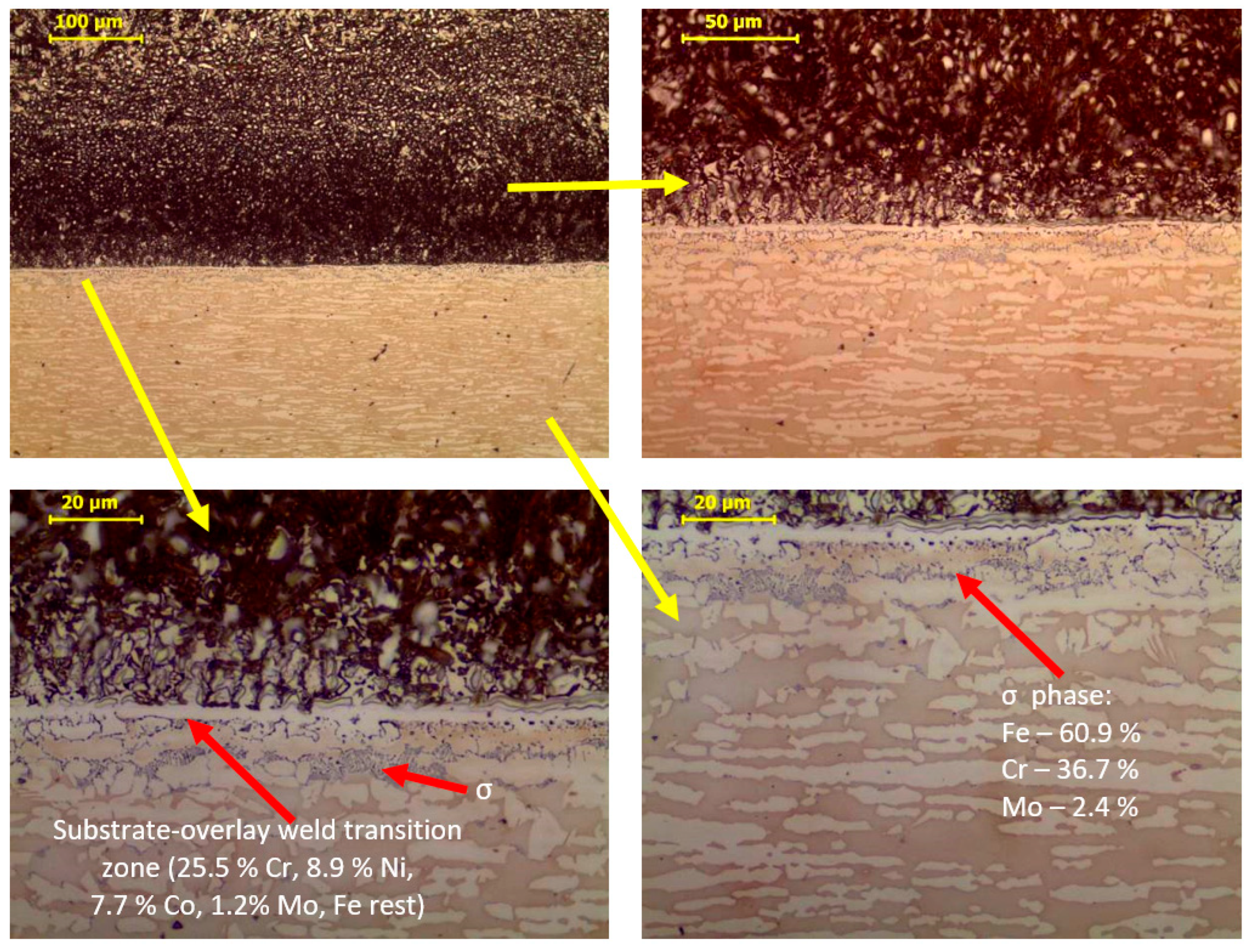

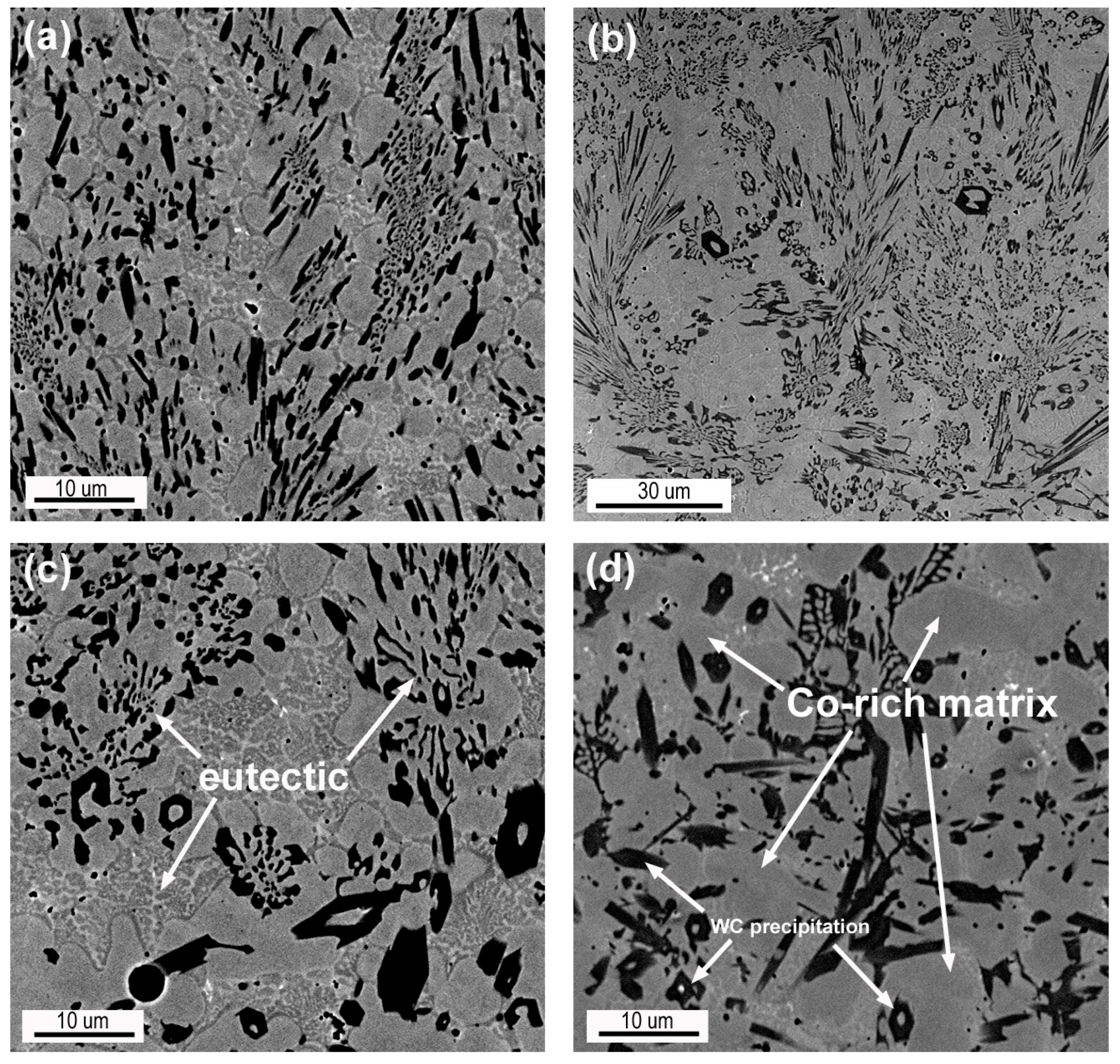
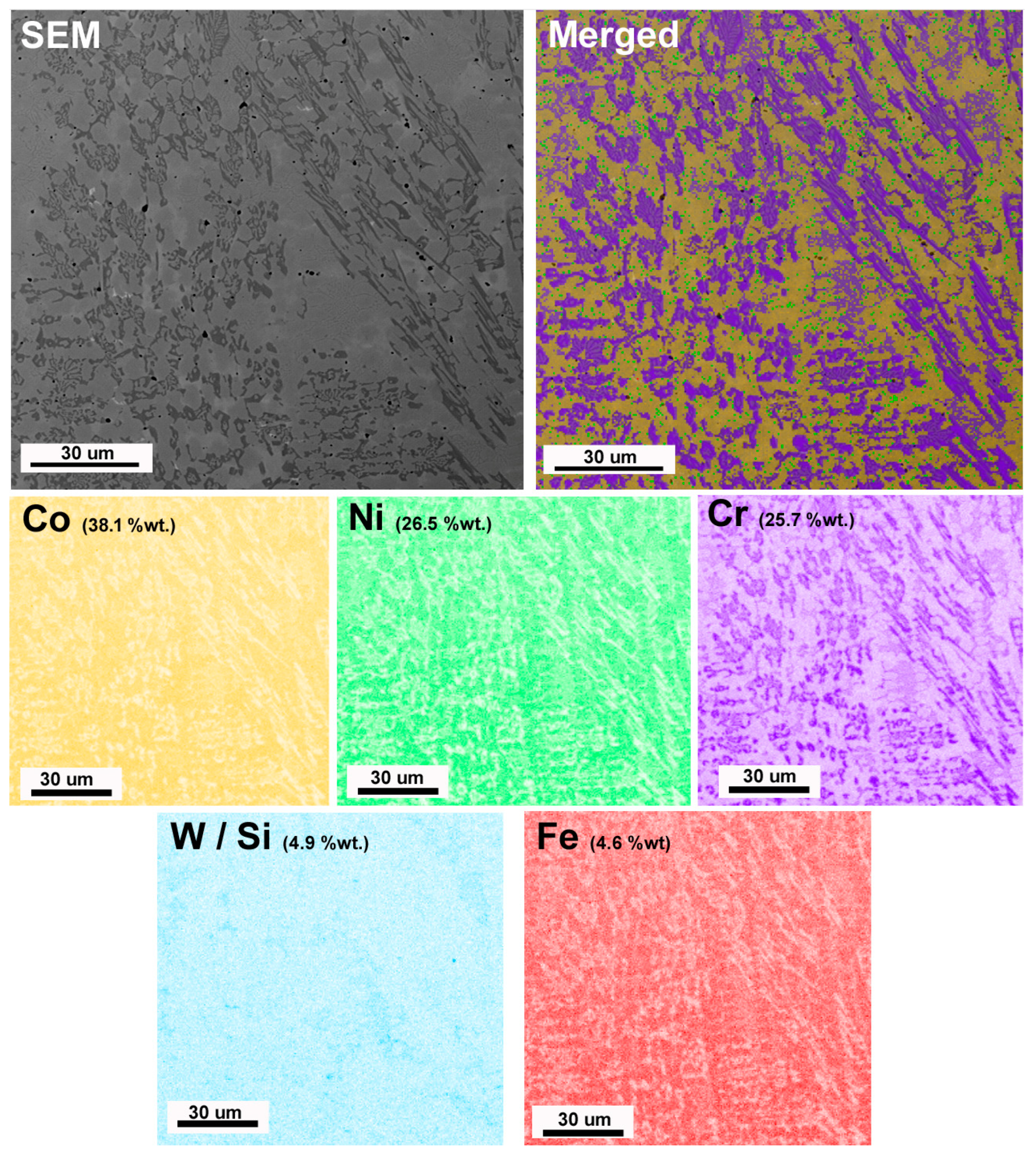
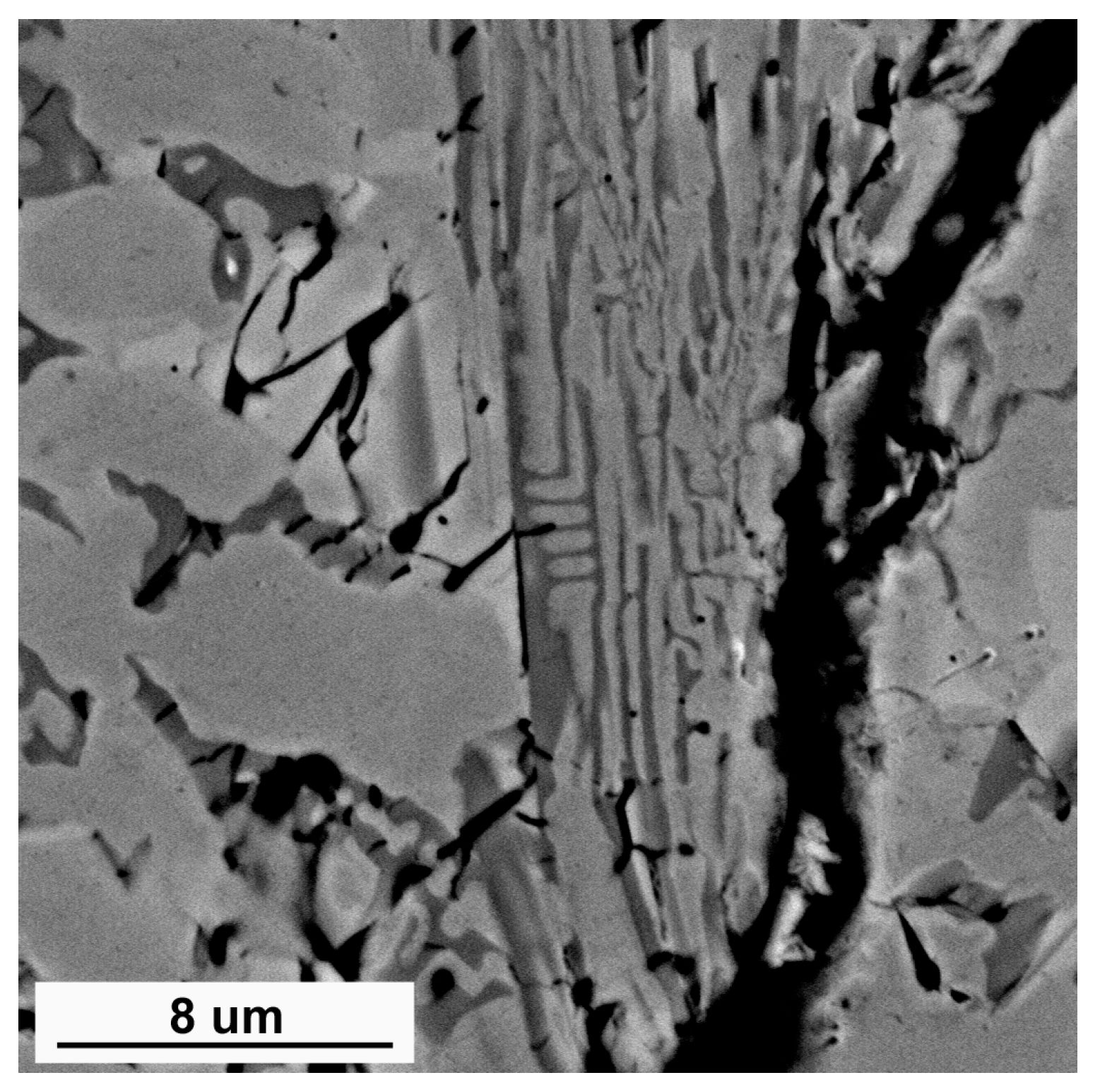
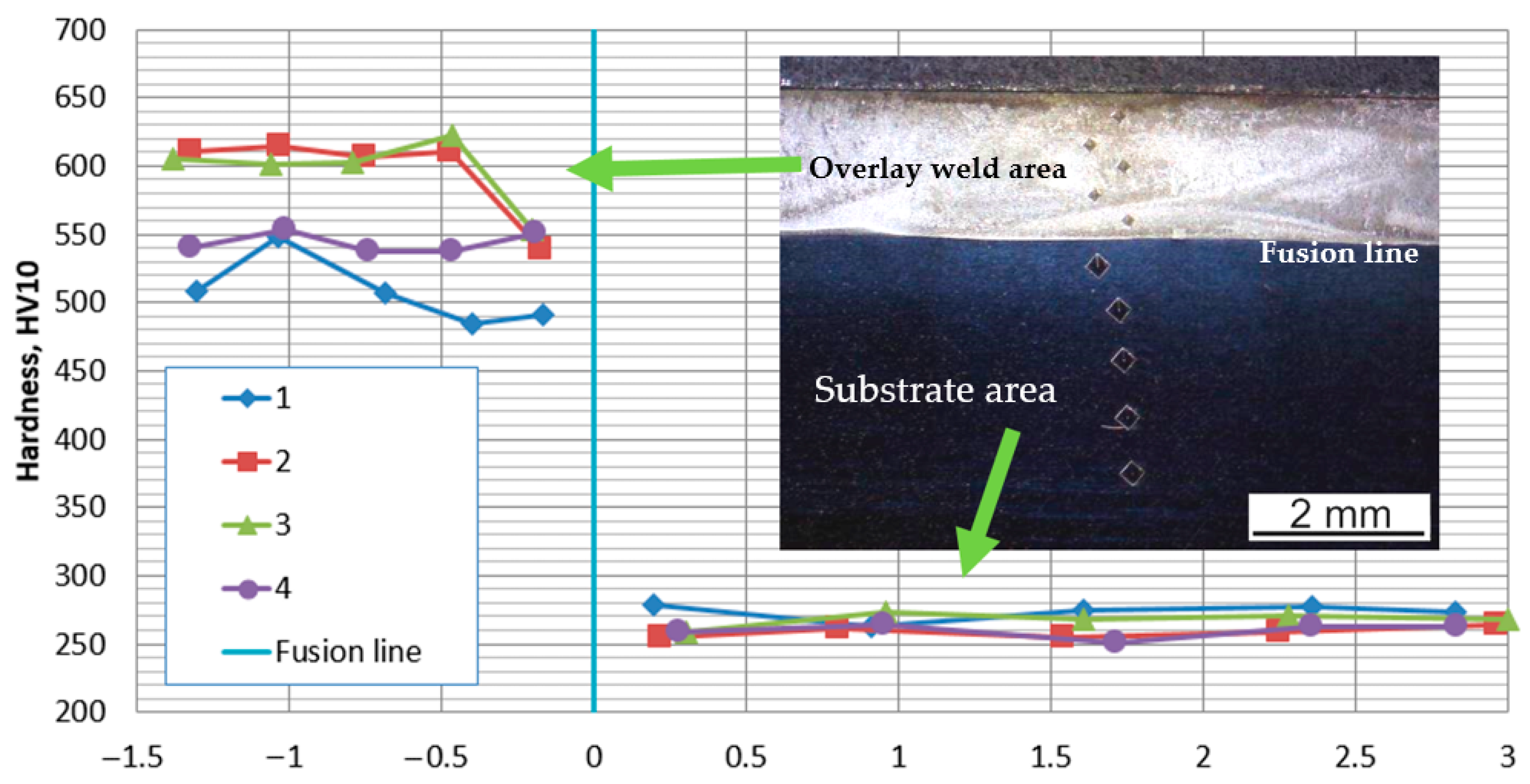
| C | Co | Cr | Ni | Si | P | S | Cu | Mo | Nb | Ti | N | Mn | Al |
|---|---|---|---|---|---|---|---|---|---|---|---|---|---|
| 0.022 | 0.058 | 22.8 | 4.6 | 0.28 | 0.03 | 0.004 | 0.23 | 2.6 | 0.007 | 0.001 | 0.18 | 1.8 | 0.02 |
| B | C | Cr | Fe | Ni | Si | W | Co |
|---|---|---|---|---|---|---|---|
| 1.71 | 1.48 | 24.86 | 0.21 | 33.00 | 1.00 | 4.22 | Bal. |
| Area | Line No. | Test Sample No. | Average | ||||
|---|---|---|---|---|---|---|---|
| 1 | 2 | 3 | 4 | 5 | |||
| Substrate | 1 ÷ 4 | 259 ± 3 | 262 ± 5 | 263 ± 2 | 259 ± 3 | 261 ± 4 | 261 ± 4 |
| Overlay weld | 2 and 3 | 596 ± 14 | 612 ± 11 | 609 ± 16 | 591 ± 20 | 624 ± 9 | 606 ± 12 |
| 1 and 4 | 546 ± 29 | 558 ± 19 | 564 ± 27 | 552 ± 24 | 576 ± 29 | 559 ± 23 | |
Disclaimer/Publisher’s Note: The statements, opinions and data contained in all publications are solely those of the individual author(s) and contributor(s) and not of MDPI and/or the editor(s). MDPI and/or the editor(s) disclaim responsibility for any injury to people or property resulting from any ideas, methods, instructions or products referred to in the content. |
© 2025 by the author. Licensee MDPI, Basel, Switzerland. This article is an open access article distributed under the terms and conditions of the Creative Commons Attribution (CC BY) license (https://creativecommons.org/licenses/by/4.0/).
Share and Cite
Tuz, L. An Evaluation of the Microstructure and Hardness of Co-Rich PTA Overlays on a Duplex Steel Substrate. Coatings 2025, 15, 69. https://doi.org/10.3390/coatings15010069
Tuz L. An Evaluation of the Microstructure and Hardness of Co-Rich PTA Overlays on a Duplex Steel Substrate. Coatings. 2025; 15(1):69. https://doi.org/10.3390/coatings15010069
Chicago/Turabian StyleTuz, Lechosław. 2025. "An Evaluation of the Microstructure and Hardness of Co-Rich PTA Overlays on a Duplex Steel Substrate" Coatings 15, no. 1: 69. https://doi.org/10.3390/coatings15010069
APA StyleTuz, L. (2025). An Evaluation of the Microstructure and Hardness of Co-Rich PTA Overlays on a Duplex Steel Substrate. Coatings, 15(1), 69. https://doi.org/10.3390/coatings15010069






